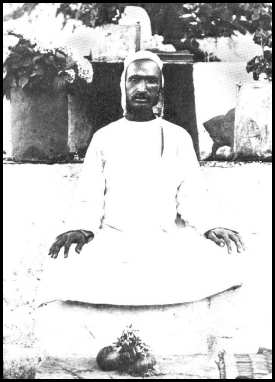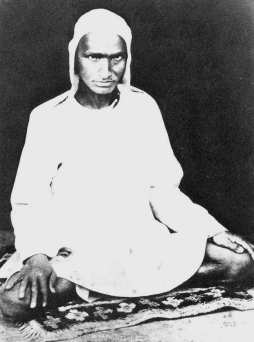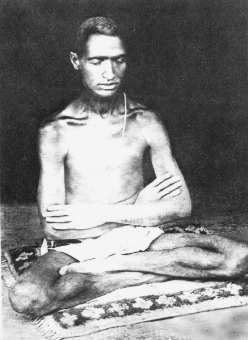Who was this person called in the West Babaji after his story was first told in
Autobiography of a Yogi? Actually the name Babaji is somewhat generic and has
been applied to many sages over the years. The word Baba means father and the
suffix "ji" is one of respect. But the Babaji written about here is called by
many names such as Mahavatar Babaji, Hariakhan Babaji, Babaji Maharaj (great
king), Shiva Baba (denoting his close connection to God Shiva), also Bhagavan
Sadashiva, Sri Sadashiva, Mahamunindra, and Sri Sri Baba.
Hariakhan Baba
Maharaj is a Great One, said to have been alive for thousands of years, dwelling
in various caves in the Himalayas, appearing sometimes among men to accomplish
some particular goal but always watching over the welfare of mankind from the
sidelines. Though many people saw him in both the 19th and the 20th century, his
appearance was always that of a young man in early manhood. He was tall and
slender with a noble and dignified appearance and in nature was humble, kind and
childlike. His complexion was light and his hair sometimes worn long and
sometimes short. Details of his appearance varied even when he was observed by
several people at the same time. He spoke little and seldom ate unless given
food by devotees. He never slept, and when on the move, he walked very fast. His
appearances and disappearances were always sudden and unexpected. He had great
strength of body and was often seen lifting huge rocks. Sometimes he was seen
with several Tibetan Lamas and in fact Babaji was often seen wearing a shirt and
Tibetan cap over his head. He spoke a mixture of many languages including
Nepali, Hindi, and Kurmachal languages. Whenever he talked to anyone from a
particular region of India, he spoke to them fluently in their own native
language. Nobody knows when he was born or where. He had all the known siddhas
(Yogic powers) and occasionally performed miracles in a natural way according to
the circumstances at hand. But mostly people were drawn to him because of the
bliss they experienced in his presence.
He appeared in many places in
Northern India near the Himalayas between 1861 and 1924. At that time he was
known by different names in the different regions and people didn't realize
these were different names for the same person until a man named Mahendra
Brahmachari had a vision of him in 1949. He subsequently became a devotee of
Babaji Maharaj and spent thirty-five years traveling all over India, collecting
the stories told about encounters with the great Babaji. He published these in
India under the title
Punya Smriti using the pen name Guru Charnasrit.
There was also a book about him titled
Hariakhan Baba, Known, Unknown by
Baba Hari Dass published in America in 1975 by the Sri Rama Foundation.

 Once an English commissioner was passing through Katgharia
and observed the huge crowd that had gathered around the saintly figure of
Babaji. He saw the spiritual glow emanating from the face of Babaji and he felt
peace and happiness welling up within himself. He got down from his horse and
went near to get a better look at him. Babaji directed his gaze at the man and
for a while the man stood transfixed as if hypnotized.
Once an English commissioner was passing through Katgharia
and observed the huge crowd that had gathered around the saintly figure of
Babaji. He saw the spiritual glow emanating from the face of Babaji and he felt
peace and happiness welling up within himself. He got down from his horse and
went near to get a better look at him. Babaji directed his gaze at the man and
for a while the man stood transfixed as if hypnotized. 
